Rust Family Foundation: Archaeology Grants Program
The Making of an Imperial Estate in Italy: The Ceramic Evidence
[Vagnari, Apulia, Italy]
Principal Investigator: Phyllis Maureen Carroll
Professor, University of Sheffield
Imperial properties in Italy have been studied primarily on the basis of historical texts and epigraphic evidence. The well documented archaeological sequences of occupation and diagnostic assemblages at Vagnari in Puglia offer a valuable and fresh perspective on profound changes in social and political circumstances, population mobility, and economic regimes in the context of Roman imperial ownership.
The earliest occupation material at the site of Vagnari in Apulia dates to the 4th century B.C. This, and other settlements belonging to the Italic Peuceti, such as Botromagno, Jazzo Fornasiello, and San Felice, began to be abandoned in the 3rd century, as a result of the Roman conquest of southern Italy. After lying in ruins for at least several decades, a new settlement was established on the Vagnari plateau.
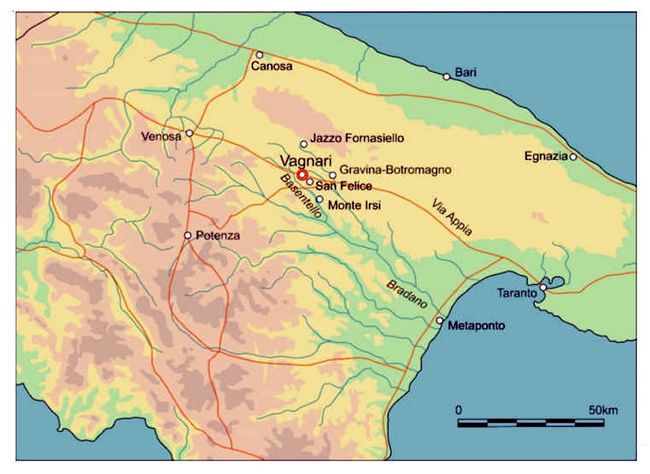
The archaeological fieldwork at Vagnari enables us to document and better understand the transformation of a late Republican agricultural settlement in private possession into a vast estate owned by the Roman emperor in ancient Apulia.
.
Fig.1: Map of Apulia and Lucania showing the location of Vagnari and other relevant sites.
Previous Work at the Site:
After the discovery of the site of Vagnari through survey and geophysical prospection, work by the University of Sheffield has concentrated since 2012 on the northern sector of the central settlement (vicus) of this vast Roman agricultural estate located near a major Roman trunk road, the Via Appia. Various structures for the processing and storage of produce from the estate lands have been excavated in the vicus, reflecting economic diversification from cereal crop cultivation to viticulture. The buildings in the settlement were occupied primarily in the first four centuries A.D., but recent exploration has shown that the imperial vicus was a successor to a Republican settlement established in the second century B.C. The second-century settlement at Vagnari attests to a resuscitation of occupation driven by Roman economic interests and reveals something about the changing dynamics of land use in this part of Apulia after the Roman conquest in the third century B.C.
Current Project (RFF-2018-63)
Goals:
The project aimed to address questions regarding the nature of Roman expansion and the changes in population and land use at Vagnari in the pivotal transition phase of the 1st century B.C to 1st century A.D. To achieve this goal, we studied the ceramic assemblages from Vagnari, especially those that were deposited at the
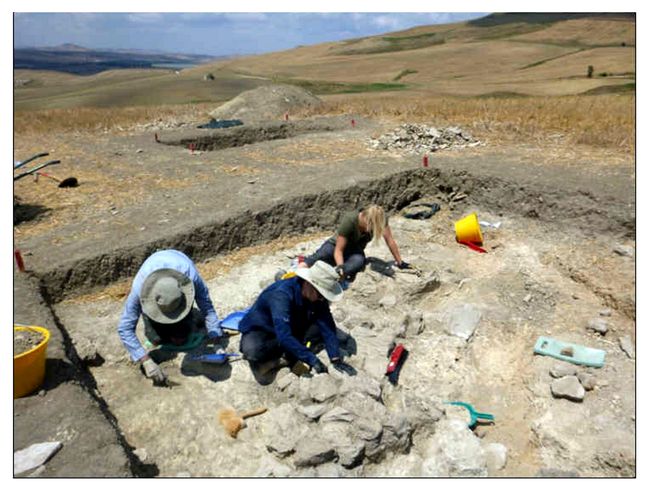 time when the
emperor chose to establish a revenue base in this region in southern
Italy. We hoped to be able to pinpoint the exact date of the emperor’s
acquisition of the site and to ascertain where the material culture of
the first Roman imperial settlers was imported from. We also strove to
ascertain, through the ceramic record, what trade networks existed and
how they changed, what imported commodities might have found their way
to Vagnari, and how they were consumed in the early Roman imperial
period.
time when the
emperor chose to establish a revenue base in this region in southern
Italy. We hoped to be able to pinpoint the exact date of the emperor’s
acquisition of the site and to ascertain where the material culture of
the first Roman imperial settlers was imported from. We also strove to
ascertain, through the ceramic record, what trade networks existed and
how they changed, what imported commodities might have found their way
to Vagnari, and how they were consumed in the early Roman imperial
period. Fig.2: Students and staff excavating soil deposits and walls of the early 1st century A.D.
Methodology:
An extensive programme of spot dating was undertaken, with pottery from 33 contexts assessed for potential to provide a chronological framework for contexts and for the site. Pottery types with established date ranges were recorded and an estimated date for each context was proposed. All contexts were dated purely on the pottery present and without any consideration for stratigraphic relationships or other well-dated material (e.g. coins, small finds). In addition to the spot dating programme, it was essential to advance the pottery analysis with primary processing of some unstudied material from previous seasons at Vagnari vicus. This included the identification of major pottery ware classes present at Vagnari and their origins.
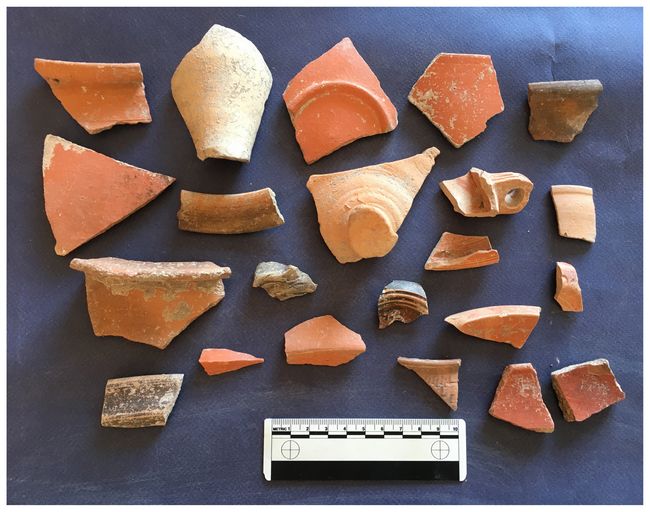
The pottery studied includes food transport containers -amphorae-, coarse wares used in storing and preparing foods, plain wares -mostly jugs and flagons-, fine wares used in drinking and serving food, thin-walled wares -primarily drinking vessels-, and ceramic oil lamps. The pottery comes from a wide range of geographical origins, including various parts of Italy, Greece, Albania, and North Africa.
Fig.3: Selection of sherds, including African Red Slip ware, local cooking wares, and fragments of lamps from Italian kilns, late 1st to 3rd century A.D.
Results from the current project:
It is now clear that the imperial settlement was developed, enlarged, and enjoyed a significant burst of activity at the very beginning of the 1st century A.D. This is the period in which the emperor - very likely Augustus- took possession of the Republican estate lands and set up the administrative and distributive centre for his imperial estate at Vagnari. The ceramics of this period were mixed with some material of the late Republican period (mainly the 1st century B.C.), largely of southern Italian manufacture. The residual material of the 1st century B.C. at Vagnari indicates that earlier structures and contexts of the Republican period were disturbed to develop the emperor’s new settlement in the first decades of the 1st century A.D.
However, apart from these residual remains, the new imperial phase of the vicus in the early 1st century A.D. is dominated by reg
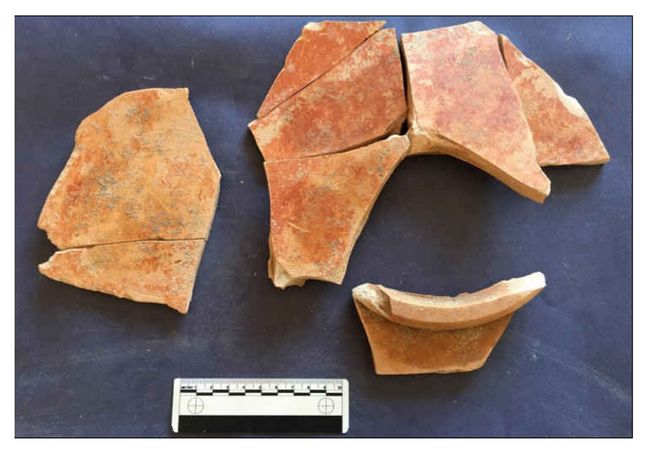 ional red-slipped and
glossy red Italian terra sigillata
wares, as well as thin-walled wares, including rare pieces of so-called
north Italian egg-shell ware (very thin drinking cups), and oil lamps
from Roman manufacturing centres. Inter-regional imports of early
imperial date include amphorae from the southern and eastern
Mediterranean regions of the Roman empire (Egypt/Palestine, Tunisia).
ional red-slipped and
glossy red Italian terra sigillata
wares, as well as thin-walled wares, including rare pieces of so-called
north Italian egg-shell ware (very thin drinking cups), and oil lamps
from Roman manufacturing centres. Inter-regional imports of early
imperial date include amphorae from the southern and eastern
Mediterranean regions of the Roman empire (Egypt/Palestine, Tunisia).
Fig.4: Sherds of two large regional red slip ware plates, early 1st century A.D.
This represents a significant change in material culture from the late Republican period when the pottery associated with the occupants of the privately-owned settlement used vessels that were regionally manufactured and typical of the Greek colonies and Italic settlements of southern Italy. It appears likely, therefore, that the new imperial settlement was populated by settlers coming from regions beyon
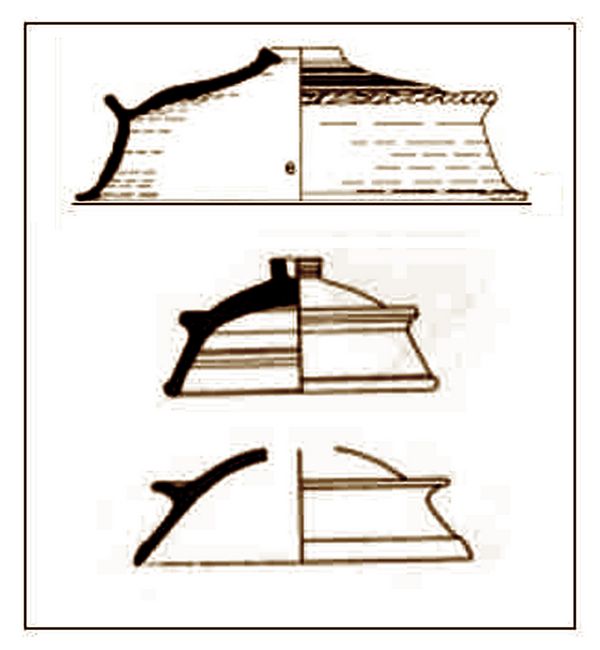 d
Vagnari, bringing their material assemblages and consumption habits
with them. Because this represents
a change in material culture from
the previous Republican period at Vagnari, when the pottery was
regionally typical of southern Italy, it is possible that the new
imperial settlement was populated by settlers coming from regions
beyond Vagnari, bringing their material assemblages and consumption
habits with them. However, strontium and oxygen isotope data from the
Vagnari cemetery suggest that, by the time the Imperial settlement was
at its productive peak (2nd-4th centuries A.D.), the population was
mainly from Vagnari or the southern Italian peninsula.
d
Vagnari, bringing their material assemblages and consumption habits
with them. Because this represents
a change in material culture from
the previous Republican period at Vagnari, when the pottery was
regionally typical of southern Italy, it is possible that the new
imperial settlement was populated by settlers coming from regions
beyond Vagnari, bringing their material assemblages and consumption
habits with them. However, strontium and oxygen isotope data from the
Vagnari cemetery suggest that, by the time the Imperial settlement was
at its productive peak (2nd-4th centuries A.D.), the population was
mainly from Vagnari or the southern Italian peninsula.Fig.5: Profile drawings of clibani, baking lids.
We were able to shed some light on cultural differences in food preparation in this transitional period from late Republican to early Imperial periods. One class of pottery worth mentioning are the ceramic domed baking lids, or clibani (fig.5), used in the late Republican settlement as portable ovens when placed over a hearth to rapidly bake flatbreads and cakes. From the 3rd century B.C., they replaced an older method in southern Italy of slow-cooking and boiling foods in deep containers. By the 1st century A.D., the Roman commercialisation of baking, especially in urban centres, may have caused their decline. The clibani at Vagnari ceased to be used by the inhabitants of the vicus beyond the early 1st century A.D. after the settlement entered imperial possession.
__________________________________________________________________________
Publications:
M. Carroll (2014), Vagnari 2012: New Work in the vicus by the University of Sheffield, in A.M. Small (ed.), Beyond Vagnari. New Themes in the Study of Roman South Italy. Bari, 79-88
M. Carroll (2016), Vagnari. Is this the winery of Rome’s greatest landowner? Current World Archaeology 76: 30-33
M. Carroll and T.L. Prowse (2016), Research at the Roman Imperial Estate at Vagnari, Puglia (Comune di Gravina in Puglia, Provincia di Bari, Regione Puglia), Papers of the British School at Rome 84: 333-336
M. Carroll and T.L. Prowse (2017), Research at the Roman Imperial Estate at Vagnari, Puglia (Comune di Gravina in Puglia, Provincia di Bari, Regione Puglia), Papers of the British School at Rome 85: 330-334
M. Carroll (2018), Preliminary Report on the University of Sheffield Excavations in the Vicus of the Roman Imperial Estate at Vagnari, Puglia, 2012-2018, FASTI ONLINE (forthcoming)
A. L. Cubberley, J. A. Lloyd and P. C. Roberts (1988),Testa and Clibani: The Baking Covers of Classical Italy, Papers of the British School at Rome 56: 98-119
M.V. Emery, R.J. Stark, T.J. Murchie, S. Elford, H.P. Schwarcz and T.L. Prowse (2018), Mapping the origins of Imperial Roman workers (1st–4th century CE) at Vagnari, Southern Italy, using 87Sr/86Sr and d18O variability, American Journal of Physical Anthropology 166.4: 837-850
T.L. Prowse and M. Carroll (2018), Research at the Roman Imperial Estate at Vagnari, Puglia (Comune di Gravina in Puglia, Provincia di Bari, Regione Puglia), Papers of the British School at Rome 86: 333-337
A.M. Small (ed.) (2011), Vagnari. Il Villaggio, l’Artigianato, La Proprietà Imperiale. The Village, The Industries, The Imperial Property. Bari
Vagnari Vicus Archaeological Project website:
https://www.sheffield.ac.uk/archaeology/research/vagnari
Recent Foundation grants: general Archaeology Grants Program w/map
Copyright © 2019 Rust Family Foundation